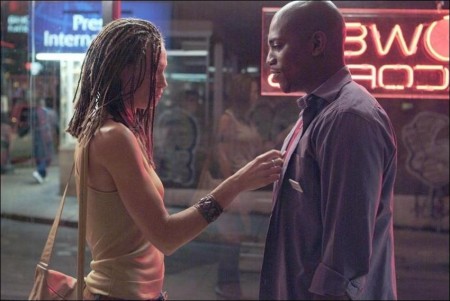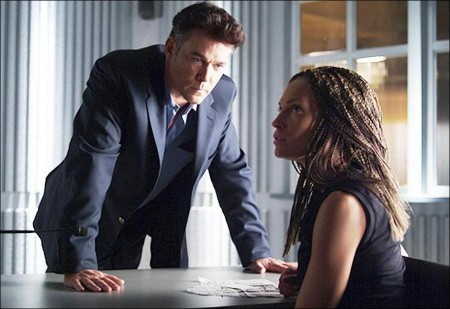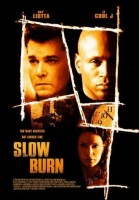Tagline: The truth is just a trick of light…
A district attorney (Ray Liotta) is involved in a 24-hour showdown with a gang leader (LL Cool J) and is, at the same time, being manipulated by an attractive assistant district attorney (Jolene Blalock) and a cryptic stranger.
Slow Burn is a sexy, stylish, thriller, featuring an all-star cast including Ray Liotta, LL Cool J, and Mekhi Phifer. Ray Liotta plays Ford Cole, a big-city district attorney with his eye on the mayor’s office and a big problem on his hands. One of his deputies, the beautiful assistant district attorney, Nora Timmer (Jolene Blalock), has just confessed to killing a man in what she claims was self-defense.
A bad situation gets worse when an enigmatic stranger named Luther Pinks (James Todd Smith aka LL Cool J) turns up at the police station to contradict Nora’s story and paint a very different picture of Ford’s talented colleague. With his career and perhaps his life on the line, Ford has a mere handful of hours to sort the truth from the lies in a saga involving Nora, a record store clerk (Mekhi Phifer), and a powerful gang lord. Slow Burn is a tale of duplicity and deception that turns the standard notions of identity and perception upside down. “It’s a story of chameleons,” says writer / director Wayne Beach. “The film plays games with identity and people who are not whom they seem to be.”
About the Production
When District Attorney Ford Cole must solve a murder tied to his lover, Assistant D.A. Nora Timmer, his investigation is further complicated by the conflicting testimony of Luther Pinks, an enigmatic stranger who may or may not be telling the truth. In a matter of hours, Cole is launched into a labyrinth of shifting identities, betrayals and larger crimes, one which proves just how little he knows about who Nora really is, or where her loyalties lie.
“Every character in this movie is reinventing him or herself,” explains Beach. “For Nora, reinvention is a sport. Cole is a former street cop who’s transformed himself into a D.A. and is on the road to becoming mayor. And Luther Pinks reinvents himself throughout the story as the need requires.”
For Beach, whose credits include the two Wesley Snipes films, Art of War and Murder at 1600, Slow Burn was an opportunity to write the kind of movie he most wanted to see. “I love mysteries like Chinatown, which are layered and open up into new rooms and new compartments,” says the writer. “Slow Burn is a brain tease. It takes you places you don’t expect to go and don’t see coming.”
Beach spent five years writing and developing Slow Burn before it came to the attention of renowned casting director and producer Bonnie Timmermann. Timmermann immediately reacted to the script and came on board as a producer. “The script was amazingly well-written, well-crafted and commercial, and it had great casting potential,” says Timmermann.
Timmermann and Beach immediately agreed that Ray Liotta would be ideal for the role of Cole. Explains Beach, “Ray burns a hole in the screen. He has intensity and drive, and those qualities make you believe that Cole could pull himself up from street cop to mayoral candidate. I also wanted to show a new side of Ray: a complex, vulnerable and sexual side.”
Ray Liotta was flattered when Timmermann offered him the part, and ready to commit the moment he finished Beach’s script. “I was drawn to this project because my character, Ford, is reactive,” says Liotta. “I usually play strong, passionate characters who go after other people, who know exactly what they are doing and why they are doing it. In Slow Burn, I try to put together a puzzle as it unravels and realize that it unravels deeply into my personal life.”
“Ford sees the world as a series of questions for which he has all the answers,” continues Beach. “Then he meets Nora, who tantalizes and intrigues him. She’s the lingering mystery in his life.
While Liotta admits he is usually reluctant to work with first time directors, he had no qualms once he met Beach. “I liked Wayne,” says Liotta. “When he showed me his storyboards I saw how he had been living with this project. It was a long journey for him but also a passionate journey – and to me passion wins out in the long run.”
Beach was equally impressed with Liotta’s dedication to his craft, as well as his commitment to the project. “Ray embarks upon a laser-like search for the truth of a character,” says the director. “He disciplines both his body and spirit to radiate the character’s soul. From working out three hours a day to spending months researching the habits and world of his character, he inspired me with his devotion to his craft.”
Following Liotta’s involvement, Timmermann brought Slow Burn to New York’s GreeneStreet Films, an independent production company founded by John Penotti and Fisher Stevens, which quickly came on board. “We were attracted to the script because it’s intelligent and requires some mental gymnastics,” says producer Tim Williams, who is also GreeneStreet’s Head of Production. “We knew that – if it were properly executed – it would appeal to fans of classic film noir and younger audiences as well.”
Once GreeneStreet became involved, the project moved forward remarkably quickly. GreeneStreet partnered with producer Sidney Kimmel of Sidney Kimmel Entertainment and brought on Andrew Karsch of Longfellow Pictures to executive produce. “All of our intentions were in synch,” says Williams. “We all agreed on what we needed to do to make this movie within the framework of budget and schedule.”
Finding an actress to play Nora was a longer process, however. Since Nora is a character of seemingly endless layers and dimensions, Beach wanted an unknown actress to play the part. He explains, “For reasons that will become apparent when one sees the movie, I didn’t want an audience to have preconceived ideas about who this actress is. I wanted as much of a blank slate as possible.”
After auditioning over 500 actresses from Australia, London, New York and Los Angeles, Beach and the producers cast actress Jolene Blalock in what would be her first feature film role. “I remember the night that I got Jolene’s tape and my jaw dropped,” Beach recalls. “Suddenly I realized we were looking at Nora. It was eleven at night, and I called everybody. I said, ‘Lock her down. This is it. I think we found her.’”
Known primarily for her television work on the series Enterprise, Blalock recognized the role of Nora, a character who is motivated by a multitude of forces, as a rare and welcome challenge. “I knew that I would have to have every moment together, or else she would not be believable,” she says. “It was a huge challenge to put that puzzle together and it stirred up a fire inside me.”
“The truth is a shifting commodity for Nora. She’s a modern variation on the classic ‘femme fatale’ character,” says Beach. “We can never be sure whether or not to trust her version of events.” Adds Stevens, “Jolene had to use many different acting techniques to bring Nora to life. She did an incredible job.”
Working with Liotta, with whom she has a steamy love scene in Slow Burn, “was amazing,” recalls Blalock. “He cares about the essence of a scene, not just the angle or the beauty of the shot. He really fights for the quality of the art and that is admirable.”
Rounding out the murky triangle of Slow Burn is James Todd Smith – known to most audiences as the multi-platinum, Grammy-winning hip-hop pioneer LL Cool J – in the role of Luther Pinks. A confident, almost arrogant, Cheshire-cat character whose smile hides many secrets, Luther engages Cole in a shifting battle of wills. The part immediately appealed to Smith, “I really liked the character. Luther has an interesting duality. Is he good? Is he bad? I thought it was kind of sexy. And a challenge.”
“I tried to build the character from the ground up,” says Smith of Luther Pinks. “I don’t think he’s evil or necessarily good. He’s doing what he feels is right. The character’s perspective was already, obviously, in the script. I took that and absorbed it. I began to live in the truth of who Luther is.”
Smith was particularly pleased with the chemistry he and Liotta forged on the set of Slow Burn. “It was great working with Ray. We both were really in the same world together. I believed him. He believed me. There was an actual connection and actual thoughts behind the words.”
Much to Beach’s pleasure, Slow Burn continued to attract strong and notable actors during the casting process. Mekhi Phifer (Clockers, Soul Food) joined the cast as Isaac, a bohemian record store clerk who falls for Nora and finds himself involved in a complicated love triangle. “Isaac is an artist. He loves music. And his converted garage is filled with found objects that he incorporates into sculptures,” says Phifer. “He’s an innocent, but when he gets caught up with Nora, he’s taken on a messy roller coaster ride. The audience will be shocked.”
Noted London-based actor Chiwetel Ejiofor (Dirty Pretty Things, Inside Man) accepted the part of Ty Trippin, a British journalist who is writing a piece on Cole and his political ambitions. Trippin approaches Cole in a very light-hearted manner, hoping to make the D.A. relaxed enough to be candid. “In another world, we would have gotten along very well,” says Ejiofor. But at the end of the film an unexpected twist throws the relationship into jeopardy.
Taye Diggs (How Stella Got Her Groove Back, Rent) rounds out the cast as Jeffrey Sykes, a sophisticated gang member who is brought in for questioning by Cole. Diggs was most impressed by the intensity of Liotta’s performance. “He came at me with such force and with so much reality. All I really had to do was be in character and react,” he says. “Actors like Ray are always wonderful to work with because they force great performances out of others.”
Slow Burn was shot over seven weeks during a sweltering July and August in Montreal. Montreal was chosen over many cities scouted because “it has grit, heart, and a sense of history that newer cities just don’t have,” says Williams. “Wayne wanted to shoot the movie where it seemed that a new city was encroaching on the old. There are so many places in Montreal where you get that feeling.”
Director of photography Wally Pfister (Insomnia, Memento) mesmerized everyone on set with his unique lighting and camera work. “I was attracted to Slow Burn because it’s full of darkness and mood – a true ‘film noir.’ That’s the kind of material I am most inspired by,” he says.
Pfister avoided giving Slow Burn a typically commercial look. He did not use filters on the camera lens, preferring instead to use blue-green mercury vapor and reddish sodium vapor lighting to give an urban look to the film. Pfister also used Kodak Vision 218 film, a new, high-speed stock that requires less light yet still yields remarkable definition. With it he was able to shoot both dark and moody subjects as well as brightly lit subjects in the same scene.
“My objective was to reflect the themes of shifting identity in the story by playing with shifting light and shadow,” explains Pfister.
Says Williams, “In a typical movie, the lighting is highly stylized, sometimes to the detriment of the story. But Wally’s lighting was very subtle and yet strong. He used a lot of rim lighting, in which the outline of the face was lit, not the face itself. He also used book lighting where two large lights are funneled into a little sliver – when the characters move, they’re constantly moving in and out of light.”
To enable principal photography to be accomplished in seven weeks, the production invested heavily in electrical and camera equipment. “We had four separate lighting packages with us in order to move quickly and change locations frequently,” says co-producer Matthew Rowland. “We pre-rigged all our studio sets so we never had to wait long for set ups. We also used a larger than usual camera package, with many more lenses, so that Wally could attain a sophisticated visual image.”
Since Slow Burn’s story takes place after midnight, the production shot mostly at night, which proved to be a challenge for the cast and crew. Beach explains, “It’s difficult to shoot at night on a tight schedule and to move quickly. But I had storyboarded many of the scenes ahead of time. And I was blessed to be working with Wally Pfister. We planned all the shots ahead.”
Beach successfully navigated several challenging technical sequences over the course of the shoot. One was a massive fire that occurs at a gas station. The other was a riot scene in which residents of a housing complex throw garbage and rocks at ambulances, fire trucks and police. This scene was filmed in one night in an actual housing co-op in downtown Montreal, with production blocking off two street blocks and a square.
Despite years in the Hollywood trenches as a screenwriter, Beach acknowledges that Slow Burn was an ambitious project to take on as a first-time director. “My desire to direct was, in many ways, my original impulse,” he says. “I’ve been making short films since I was 14. I was visually driven from an early age. It’s always been a plan of mine.”
Now that Slow Burn is finished, Beach can finally mark the end of the long seven-year journey he took to bring the film to audiences. “I worked on this script for so long. I wrote twenty-one drafts of the screenplay,” says the director. “It’s a strange feeling to suddenly be seeing these scenes on screen and realizing they’re actually done. It’s a terrific feeling.”
Production notes provided by Lionsgate Films.
Slow Burn
Starring: Ray Liotta, LL Cool J, Jolene Blalock, Nora Timmer, Taye Diggs, Chiwetel Ejiofor, Donny Falsetti, Mekhi Phifer
Directed by: Wayne Beach
Screenplay by: Wayne Beach
Release Date: April 13th, 2007
MPAA Rating: R for sexuality, violence and language.
Studio: Lionsgate Films
Box Office Totals
Domestic: $1,237,615 (68.9%)
Foreign: $559,641 (31.1%)
Total: $1,797,256 (Worldwide)




